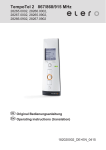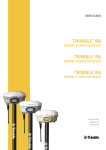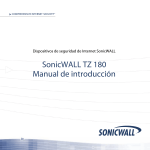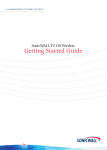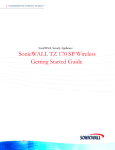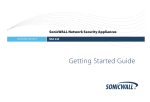Download SonicWALL Internet Security Appliances Network Router User Manual
Transcript
COMPREHENSIVE INTERNET SECURITY ™ b SonicWALL Internet Security Appliances SonicWALL TZ 180 Wireless Getting Started Guide SonicWALL TZ 180 Wireless Getting Started Guide Thank you for your purchase of the SonicWALL TZ 180 Wireless, the ultimate security platform for home and small office deployments. With integrated support for SonicWALL's Gateway Anti-Virus, the SonicWALL TZ 180 Wireless delivers powerful, yet easy-to-use protection against hackers and viruses. The SonicWALL TZ 180 Wireless also provides support for SonicWALL's Content Filtering Service to provide enhanced productivity and network utilization. This Getting Started Guide contains installation procedures and configuration guidelines for deploying a SonicWALL TZ 180 Wireless on your network. For detailed configuration information, refer to the SonicOS Standard Administrator’s Guide on the SonicWALL Resource CD or on the Web at: <http://www.sonicwall.com/us/support.html>. SonicWALL TZ 180 Wireless Getting Started Guide Page 1 Document Contents This document contains the following sections: 1 Completing Pre-Configuration Tasks - page 3 2 Registering Your SonicWALL - page 9 3 Connecting for Initial Setup - page 11 4 Running the Setup Wizard - page 17 5 Connecting to Your Network - page 23 Appendix Appendix A: Configuring DHCP IP Addressing - page 27 Appendix B: Safety Instructions and Regulatory Information - page 28 Page 2 Completing Pre-Configuration Tasks 1 In this Section This section provides pre-configuration information. It is necessary to review this section before setting up your SonicWALL TZ 180 Wireless. • • • • System Requirements section, on page 4 Check Package Contents section, on page 5 Obtain Configuration Information section, on page 6 Obtain Internet Service Provider (ISP) Information section, on page 7 SonicWALL TZ 180 Wireless Getting Started Guide Page 3 System Requirements Before you begin the setup process, check to ensure that you have a computer that meets the following requirements. This computer is used to manage your SonicWALL TZ 180 Wireless during the setup process. • • • • • Windows XP, Windows 2000, or Windows NT 40MB of disk space available One available 10/100 Ethernet (LAN) port A Web browser supporting Java and HTTP uploads. Internet Explorer 6.0 or higher, Netscape Navigator 4.7 or higher, Mozilla 1.7 or higher, or Firefox are recommended LAN interface set to obtain an IP address automatically (DHCP addressing enabled). Note: In order to connect to the SonicWALL TZ 180 Wireless, your computer must be set to obtain an IP address automatically using DHCP. For more information on configuring DHCP on your computer, turn to Appendix A: Configuring DHCP IP Addressing section, on page 27. Page 4 System Requirements Check Package Contents 1 2 3 4 5 6 7 8 9 10 Any Items Missing? If any items are missing from your package, please contact SonicWALL support. SonicWALL TZ 180 Wireless Standard power adapter Wireless Antennas Pair Ethernet cable Getting Started Guide SonicWALL Recommends Guide Release Notes Thank You card Resource CD Security Services card 5 A listing of the most current support options is available online at: <http://www.sonicwall.com/us/support.html> *The included power cord is intended for use in North America only. For European Union (EU) customers, a power cord is not included. 6 COMPREHENSIVE INTERNET SECURITY 7 COMPREHENSIVE INTERNET SECURITY SonicOS Release Notes 1 wlan wan opt 1 2 3 4 5 on/act link/act WiFiSec 10/100 SonicWALL Getting Started Guide TZ 180 wireless SonicWALL Recommends Guide Contents 8 Thank You 2 9 10 SonicWALL Resource CD 3 4 SonicWALL TZ 180 Wireless Getting Started Guide Page 5 Obtain Configuration Information Please record the following setup information and keep it for future reference: Registration Information Serial Number: Record the serial number found on the bottom panel of your SonicWALL appliance. Authentication Code: Record the authentication code found on the bottom panel of your SonicWALL appliance. Networking Information LAN IP Address: . . . Subnet Mask: . . . Ethernet WAN IP Address: . . . Select a static IP address for your SonicWALL appliance that is within the range of your local subnet. If you are unsure, you can use the default IP address (192.168.168.168). Record the subnet mask for the local subnet where you are installing your SonicWALL appliance. Select a static IP address for your Ethernet WAN. This setting only applies if you are already using an ISP that assigns a static IP address. Administrator Information Admin Name: Select an administrator account name. (default is admin). Admin Password: Select an administrator password. (default is password). Page 6 Obtain Configuration Information Obtain Internet Service Provider (ISP) Information Record the following information about your current Internet service: If you connect via You likely use Please record Cable modem, DSL with a router DHCP No Internet connection information is usually required, although some service providers require a host name. Host Name: Home DSL PPPoE User Name: Password: Note: Your ISP may require your user name in the format: name@ISP.com T1/E1, Static broadband, Cable or DSL with a static IP Static IP IP Address: . Subnet Mask: . Default Gateway (Router IP Address): Primary DNS: . Secondary DNS . (optional): Dial-in to a server PPTP . . . . . . . . . . . Server Address: User Name: Password: SonicWALL TZ 180 Wireless Getting Started Guide Page 7 Page 8 Obtain Internet Service Provider (ISP) Information Registering Your SonicWALL 2 In this Section This section provides instructions for registering your SonicWALL TZ 180 Wireless. • Registering with MySonicWALL.com section, on page 10 Note: Product registration is an important part of the setup process, allowing you to enable product support, firmware updates and other key features. SonicWALL TZ 180 Wireless Getting Started Guide Page 9 Registering with MySonicWALL.com 1. 2. If you do not yet have a mysonicwall.com account, point your web-browser to <http://www.mysonicwall.com/> to register before continuing. Locate and record your SonicWALL TZ 180 Wireless Software Serial Number and Authentication Code. This information is printed on the bottom panel of the appliance. My Serial Number My Authentication Code 3. 4. In your Web browser, go to <https://www.mysonicwall.com> and login with your mysonicwall.com username and password. Enter your serial number in the Quick Register field and click the small gray arrow. Follow the on-screen instructions. 5. 6. 7. Confirm your serial number. Enter a friendly name for this appliance. Enter your authentication code. 8. 9. Click the Register button to continue. Follow the online prompts to complete the registration process. Page 10 Registering with MySonicWALL.com Connecting for Initial Setup 3 In this Section This section provides initial configuration instructions for connecting your SonicWALL TZ 180 Wireless. • • • • • Connect Antennas section, on page 12 Apply Power section, on page 12 Connect WAN Port to the Internet section, on page 14 Connect the Computer to the LAN (1) Port section, on page 14 Verify WAN / LAN / WLAN Connection section, on page 15 SonicWALL TZ 180 Wireless Getting Started Guide Page 11 Connect Antennas 1. 2. 3. Attach each of the (2) included antennas to an antenna port on the back of the SonicWALL TZ 180 Wireless. Screw the end of the antenna clockwise to tighten. Adjust the antennas to meet your space / signal requirements. Console WAN OPT 5 4 3 2 1 Power Apply Power 1. Connect the AC plug to the power supply. 2. Plug one end of the power supply to the back of the SonicWALL TZ 180 Wireless. Page 12 Connect Antennas 3. Connect the AC plug to an appropriate power outlet. 3 2 1 Power To AC power To SonicWALL TZ 180 Wireless The Power LED on the front panel lights up green when you power the SonicWALL TZ 180 Wireless. The Test LED lights up and blinks while the appliance performs a series of diagnostic tests. When the Test LED is no longer lit, the SonicWALL TZ 180 Wireless is ready for configuration. If the Test LED stays lit for more than a few minutes, cycle power to the appliance. SonicWALL TZ 180 Wireless Getting Started Guide Page 13 Connect WAN Port to the Internet Using a standard network cable, connect the WAN port of the SonicWALL TZ 180 Wireless to your gateway device (usually your cable/DSL modem or T1 router). Console WAN OPT 5 4 3 2 1 Power SonicWALL TZ 180 Wireless Internet Router / Modem Connect the Computer to the LAN (1) Port Using the supplied network cable and the computer, connect the LAN (Ethernet) port on the computer to the LAN (1) port on the back of your SonicWALL TZ 180 Wireless. Console WAN OPT 5 4 3 2 SonicWALL TZ 180 Wireless LAN (Ethernet) Management Computer Page 14 Connect WAN Port to the Internet 1 Power LAN (1) Verify WAN / LAN / WLAN Connection Once the cables are correctly connected, the WAN, LAN (1) and WLAN lights on the front panel of your SonicWALL TZ 180 Wireless illuminate as illustrated below: Link/ACT (WAN / 1) - Indicates a network connection is present between the SonicWALL TZ 180 Wireless and another network appliance. 10/100 (WAN / 1) - A green light Indicates a 10mbps port connection. An amber light indicates a 100mbps port connection. WLAN (on/act) - A solid light indicates the wireless transmitter is powered on. A blinking light indicates wireless activity. Note: In order to connect to the SonicWALL TZ 180 Wireless, your computer must be set to accept dynamic “DHCP” addressing. For more information on configuring DHCP, turn to Appendix A: Configuring DHCP IP Addressing section, on page 27. SonicWALL TZ 180 Wireless Getting Started Guide Page 15 Page 16 Verify WAN / LAN / WLAN Connection Running the Setup Wizard 4 In this Section This section provides instructions to log in and configure your SonicWALL TZ 180 Wireless using the SonicWALL Setup Wizard. • • • • Log into the Web Management Interface section, on page 18 SonicWALL Setup Wizard section, on page 20 Verify Management Interface Connectivity section, on page 21 Verify WAN (Internet) Connectivity section, on page 22 Tip: Before completing this section, fill out the information in Obtain Configuration Information section, on page 6 and Obtain Internet Service Provider (ISP) Information section, on page 7. You will need to enter this information during the Setup Wizard. SonicWALL TZ 180 Wireless Getting Started Guide Page 17 Log into the Web Management Interface Your SonicWALL TZ 180 Wireless employs the use of a Web-based management interface for setup and configuration. Complete the following steps to log into the management interface. 1. In a Web browser on the computer, navigate to http://192.168.168.168 (the default IP address of the SonicWALL TZ 180 Wireless). The SonicWALL Web management login screen displays: Note: Depending on your browser settings, one or more security warnings may display while connecting to the SonicWALL Secure Anti-Virus Router 80 Web management interface. Choose to accept the certificates in order to log into the appliance. 2. Log into the SonicWALL TZ 180 Wireless using “admin” as the user name and “password” as the password. The configuration Wizard screen displays. If you are having trouble getting the Login screen or Wizard to appear, see page 19 for additional troubleshooting information. Page 18 Log into the Web Management Interface Unable to See the Setup Wizard? • • If you see the login screen, but not the Configuration Wizard: • Configure your Internet browser to allow popups for the SonicWALL TZ 180 Wireless. • Log into the security appliance using “admin” as the user name and “password” as the password. After you log in, click the Wizards button on the System > Status page. If you do not see the login screen or the Configuration Wizard: • Did you correctly enter the SonicWALL TZ 180 Wireless management IP address, 192.168.168.168, in your Web browser? • Is your computer set to accept DHCP addressing or set to a static IP address within the 192.168.168.x subnet range? If not, see Appendix A: Configuring DHCP IP Addressing section, on page 27 for instructions on changing your Local Area Connection settings. • Do you have the Ethernet cable connected between your computer and the LAN (1) port on your SonicWALL TZ 180 Wireless? • Do you need to add the SonicWALL TZ 180 Wireless to your list of trusted sites? Use the default IP address (192.168.168.168) for this purpose. • Is the Test LED on the front panel of your SonicWALL TZ 180 Wireless lit? If the Test LED stays lit for more than a few minutes after the initial power on sequence, cycle power to the SonicWALL TZ 180 Wireless. SonicWALL TZ 180 Wireless Getting Started Guide Page 19 SonicWALL Setup Wizard 1. 2. 3. 4. If the Setup Wizard does not display upon initial log into the SonicWALL TZ 180 Wireless management interface, click the Wizards button in the left-hand navigation panel of the interface. Select Setup Wizard radio button and click the Next button to continue. Follow the on-screen prompts to complete the Setup Wizard. Refer to the information you recorded in Obtain Configuration Information section, on page 6 and Obtain Internet Service Provider (ISP) Information section, on page 7 to complete this section. Depending on the changes made during your setup configuration, the SonicWALL may restart. Page 20 SonicWALL Setup Wizard Verify Management Interface Connectivity 1. If your SonicWALL did not require a restart, skip to the Verify WAN (Internet) Connectivity section, on page 22. Otherwise, continue with step 2 2. Wait for the SonicWALL TZ 180 Wireless to reboot. When the Test LED is no longer lit, the SonicWALL TZ 180 Wireless is ready for login. If the login page does not display after reboot, open a web browser on the computer and manually navigate to the LAN IP address of your SonicWALL TZ 180 Wireless. Using your new username and password, log into the appliance. 3. 4. The System > Security Dashboard page (shown below) displays. You have correctly configured the SonicWALL TZ 180 Wireless to work with the computer on your LAN. Complete the next section to verify WAN (Internet) connectivity. SonicWALL TZ 180 Wireless Getting Started Guide Page 21 Verify WAN (Internet) Connectivity Complete the following steps to confirm your Internet connectivity. 1. 2. Using a computer connected to the LAN (1) port, launch a new Web browser. Navigate to an Internet website such as <http://www.sonicwall.com>. If the website displays, your SonicWALL TZ 180 Wireless is configured correctly as your gateway device. SonicWALL wlan wan opt 1 2 3 4 5 on/act link/act WiFiSec 10/100 TZ 180 wireless WAN LAN (1) Internet Having Trouble Connecting to the Internet? • • • • • Did you open a new browser window to launch the website? Try closing out all browser windows and launching the browser again. Is your computer set to accept DHCP addressing or, if using static IP addressing, it your IP address set to a range within the SonicWALL’s LAN subnet? Is your SonicWALL WAN port connected to your Internet source and showing (link/act, 10/100) activity? Verify that the network settings you recorded on page 6 of this guide are correct. Did you enter your network information from page 6 of this guide correctly in the Setup Wizard? If you are unsure, turn to the SonicWALL Setup Wizard section, on page 20 to run Setup Wizard again. Page 22 Verify WAN (Internet) Connectivity Connecting to Your Network 5 In this Section This section provides SonicWALL TZ 180 Wireless basic network connectivity verification and examples. • • • Connect and Configure Your Network section, on page 24 The Front Panel section, on page 25 The Back Panel section, on page 26 SonicWALL TZ 180 Wireless Getting Started Guide Page 23 Connect and Configure Your Network TZ 180 wireless Internet Local Wired Clients Your SonicWALL TZ 180 Wireless is equipped with a DHCP server. If you enabled this feature in the Setup Wizard, your DHCP-enabled network clients are automatically provisioned by the SonicWALL. Setting up your network is as simple as: 1. 2. 3. Setting your clients to obtain their IP address automatically. Connecting your clients (directly or using a hub/switch) to the LAN ports (1-5) on your SonicWALL TZ 180 Wireless. Reading the SonicOS Standard Administrator’s Guide to configure the features and security services of your SonicWALL TZ 180 Wireless. Congratulations! You have successfully completed set up of your SonicWALL TZ 180 Wireless. For more detailed information on your SonicWALL TZ 180 Wireless feature set, refer to the latest version of the SonicOS Standard Administrator’s Guide. Page 24 Connect and Configure Your Network The Front Panel wlan wan opt 1 2 3 4 5 on/act link/act WiFiSec 10/100 TZ 180 wireless Feature Description Power LED Indicates the SonicWALL TZ 180 Wireless is powered on. Test LED Solid: Indicates that the SonicWALL TZ 180 Wireless is in test mode. Blinking: The unit is first booting up, or restarting. This can also indicate that the unit is in safe mode. WLAN (on/act) Solid indicates the wireless radio is powered on, blinking indicates wireless activity. (WiFiSec) Indicates WiFiSec wireless security is operational. OPT The OPT Port is not a supported feature on the SonicWALL TZ 180 Wireless. WAN Indicates a device link, activity and connection speed on your WAN port. LAN (1-5) Indicates a device link, activity and connection speed on individual LAN ports (numbered 1-5). Link/ACT Solid: Indicates a device is connected to the specified port(s). Blinking: Indicates activity on the specified port(s). 10/100 Green: Indicates 10M connection on the specified port(s). Amber: Indicates 100M connection on the specified port(s). SonicWALL TZ 180 Wireless Getting Started Guide Page 25 The Back Panel Console WAN OPT 5 4 3 2 1 Power Feature Description Antenna Provide (2) connection points for the included wireless antennas. Connections Console Port Provides a console connection to the SonicWALL. This feature is not supported on the SonicWALL TZ 180 Wireless. WAN Port Provides a connection between your SonicWALL TZ 180 Wireless and the Internet, usually connecting through a modem or router. OPT Port The OPT Port is not a supported feature on the SonicWALL TZ 180 Wireless. Provides 5 fully-configurable ports for connection between your LAN Ports (1-5) SonicWALL TZ 180 Wireless and the devices on your network. These ports can be connected directly to a computer, or to a network switch or hub. Reset Button Provides the capability to reboot your SonicWALL TZ 180 Wireless to a special diagnostic “safe-mode”. Power Provides a power connection using the supplied AC adaptor. Page 26 The Back Panel Appendix A: Configuring DHCP IP Addressing Complete the following section based on your operating system in order to configure your management computer to obtain an IP address automatically (using DHCP addressing): Windows XP 1. 2. 3. 4. 5. From the Start menu, highlight Connect To and then select Show All Connections. Open the Local Area Connection Properties window. Double-click Internet Protocol (TCP/IP) to open the Internet Protocol (TCP/IP) Properties window. Select Obtain an IP address automatically. Click OK for the settings to take effect. Windows 2000 1. 2. 3. 4. 5. 6. From your Windows Start menu, select Settings. Open Network and Dial-up Connections. Click Properties. Highlight Internet Protocol (TCP/IP) and click Properties. Select Obtain and IP address automatically. Click OK for the settings to take effect. Windows NT 1. 2. 3. 4. 5. 6. From the Start menu, highlight Settings and then select Control Panel. Open Network. Double-click TCP/IP in the TCP/IP Properties window. Select Obtain an IP address automatically. Click OK, and then click OK again. Restart the computer for the changes to take effect. SonicWALL TZ 180 Wireless Getting Started Guide Page 27 Appendix B: Safety Instructions and Regulatory Information Regulatory Model/Type Product Name APL17-049 TZ 180 Wireless Mounting the SonicWALL • • • • • • Mount in a location away from direct sunlight and sources of heat. A maximum ambient temperature of 104º F (40º C) is recommended. Route cables away from power lines, fluorescent lighting fixtures, and sources of noise such as radios, transmitters, and broadband amplifiers The included power cord is intended for use in North America only. For European Union (EU) customers, a power cord is not included. Ensure that no water or excessive moisture can enter the unit. Allow unrestricted airflow around the unit and through the vents on the side of the unit. A minimum of 1 inch (25.44mm) clearance is recommended. Consideration must be given to the connection of the equipment to the supply circuit and the effect of overloading the circuits has minimal impact on overcurrent protection and supply wiring. Appropriate consideration of equipment nameplate ratings must be used when addressing this concern. Lithium Battery Warning The Lithium Battery used in the SonicWALL security appliance may not be replaced by the user. Return the SonicWALL security appliance to a SonicWALL-authorized service center for replacement with the same or equivalent type recommended by the manufacturer. If, for any reason, the battery or SonicWALL security appliance must be disposed of, do so following the battery manufacturer's instructions. Cable Connections All Ethernet and RS232 (Console) cables are designed for intra-building connection to other equipment. Do not connect these ports directly to communication wiring or other wiring that exits the building where the SonicWALL is located. Power Supply Information If the power supply is missing from your SonicWALL product package, please contact SonicWALL Technical Support at 408-752-7819 for a replacement. This product should only be used with a UL listed power supply marked “Class 2” or “LPS”, with an output rated 12 VDC, minimum 1.66 A. Page 28 Appendix B: Safety Instructions and Regulatory Information Weitere Hinweise zur Montage • • • • • • Wählen Sie für die Montage einen Ort, der keinem direkten Sonnenlicht ausgesetzt ist und sich nicht in der Nähe von Wärmequellen befindet. Die Umgebungstemperatur darf nicht mehr als 40 °C betragen. Führen Sie die Kabel nicht entlang von Stromleitungen, Leuchtstoffröhren und Störquellen wie Funksendern oder Breitbandverstärkern. Das eingeschlossene Netzkabel ist für Gebrauch in Nordamerikas nur vorgehabt. Für Europaïsche Union (EU) Kunden, ist ein Netzkabel nicht eingeschlossen. Stellen Sie sicher, dass das Gerät vor Wasser und hoher Luftfeuchtigkeit geschützt ist. Stellen Sie sicher, dass die Luft um das Gerät herum zirkulieren kann und die Lüftungsschlitze an der Seite des Gehäuses frei sind. Hier ist ein Belüftungsabstand von mindestens 26 mm einzuhalten. Vergewissern Sie sich, dass das Gerät sicher im Rack befestigt ist. Insbesondere muss auf nicht direkte Anschlüsse an Stromquellen geachtet werden wie z. B. bei Verwendung von Mehrfachsteckdosen. Hinweis zur Lithiumbatterie Die in der Internet Security Appliance von SonicWALL verwendete Lithiumbatterie darf nicht vom Benutzer ausgetauscht werden. Zum Austauschen der Batterie muss die SonicWALL in ein von SonicWALL autorisiertes ServiceCenter gebracht werden. Dort wird die Batterie durch denselben oder entsprechenden, vom Hersteller empfohlenen Batterietyp ersetzt. Beachten Sie bei einer Entsorgung der Batterie oder der SonicWALL Internet Security Appliance die diesbezüglichen Anweisungen des Herstellers. Kabelverbindungen Alle Ethernet- und RS232-C-Kabel eignen sich für die Verbindung von Geräten in Innenräumen. Schließen Sie an die Anschlüsse der SonicWALL keine Kabel an, die aus dem Gebäude herausgeführt werden, in dem sich das Gerät befindet. Informationen zur Stromversorgung Sollte das Netzteil nicht im Lieferumfang der SonicWALL enthalten sein, wenden Sie sich diesbezüglich an den technischen Support von SonicWALL (Tel.: +1-408-752-7819). Dieses Produkt darf nur in Verbindung mit einem nach den Normen der Underwriter Laboratories, USA als „UL-gelistet“ zugelassenen Netzteil der Kategorie „Class 2“ oder „LPS“ verwendet werden. Ausgang: 12 VDC Gleichsspannung, mind. 1,66 A. SonicWALL TZ 180 Wireless Getting Started Guide Page 29 FCC Part 15 Class B Notice NOTE:This equipment was tested and found to comply with the limits for a Class B digital device, pursuant to Part 15 of the FCC Rules. These limits are designed to provide reasonable protection against harmful interference in a residential installation. This equipment generates, uses, and can radiate radio frequency energy. And, if not installed and used in accordance with the instructions, may cause harmful interference to radio communications. However, there is no guarantee that interference will not occur in a particular installation. If the equipment does cause harmful interference to radio or television reception, which can be determined by turning the equipment off and on, the user is encouraged to try and correct the interference using one or more of the following measures: • • • • Reorient or relocate the receiving antenna. Increase the separation between the equipment and the receiver. Connect the equipment into an outlet on a circuit different from the receiver connection. Consult SonicWALL for assistance. Complies with EN55022 Class B and CISPR22 Class B. *Refer to the label on the bottom of the unit for device information including Class A or Class B FCC information. North American Authorized Channels SonicWALL declares that the APL17-049 (FCC ID: QWU-049) (IC: 4408A-049) when sold in US or Canada is limited to CH1~CH11 by specified firmware controlled in the USA. FCC RF Radiation Exposure Statement This equipment complies with FCC RF radiation exposure limits set forth for an uncontrolled environment. This equipment should be installed and operated with a minimum distance of 20 centimeters (7.9 inches) between the radiator (antenna) and your body. This transmitter must not be co-located or operating in conjunction with any other antenna or transmitter. For more information regarding the above statement, please contact SonicWALL, Inc. at: 1143 Borregas Avenue, Sunnyvale, CA 94089-1306, 1-408-745-9600. Canadian Radio Frequency Emissions Statement This Class B digital apparatus complies with Canadian ICES-003. Cet appareil numérique de la classe B est conforme à toutes la norme NMB-003 du Canada. Page 30 Appendix B: Safety Instructions and Regulatory Information VCCI Statement Regulatory Information for Korea Ministry of Information and Telecommunication Certification Number All products with country code “” (blank) and “A” are made in the USA. All products with country code “B” are made in China. All products with country code "C" or "D" are made in Taiwan R.O.C. SonicWALL TZ 180 Wireless Getting Started Guide Page 31 :/$15/$1 *+] InGoor Onl\ ' intprieur Seulement 'ell interno Soltanto 'e interior Solamente %innen VlechtV Innen Nur InGoor Somen te 7KLVHTXLSPHQWPD\EHRSHUDWHGLQ %HWULHEGLHVHU$XVUVWXQJZLUGLQQHQHUODXEW / RSpUDWLRQGHFHWpTXLSHPHQWHVWSHUPLVHGDQV $T (( I( NO &H %( )I IT 3/ *% &< )5 /T 3T &Z '( /U S. '. HU N/ (S &RXQWU\DQGFKDQQHOVHOHFWLRQLVPDGHLQVRIWZDUH)ROORZXVHU GRFXPHQWDWLRQWRPDNHFRXQWU\DQGFKDQQHOVHWWLQJ /DQGXQG.DQDODXVZDKOVLQGLQ6RIWZDUHJHPDFKW)ROJHQ6LH 9HUEUDXFKHUGRNXPHQWDWLRQXP/DQGXQG.DQDO]XPDFKHQ VHW]HQG /DVpOHFWLRQGHSD\VHWFDQDOHVWIDLWHGDQVOHORJLFLHO6XLYH]OD GRFXPHQWDWLRQG XWLOLVDWHXUSRXUIDLUHOHSD\VHWODFDQDO VpOHFWLRQ 6RQLFZDOOWtPWRSURKODãXMHåHWHQWR$3/MHYHVKRGČVH ]iNODGQtPLSRåDGDYN\GDOãtPLStVOXãQêPLXVWDQRYHQtPL VPČUQLFH(6 8QGHUWHJQHGH6RQLFZDOOHUNO UHUKHUYHGDWI¡OJHQGHXGVW\U $3/RYHUKROGHUGHY VHQWOLJHNUDYRJ¡YULJHUHOHYDQWH NUDYLGLUHNWLY() +LHUPLWHUNOlUW6RQLFZDOOGDVVVLFKGDV*HUlW$3/in hEHUHLQVWLPPXQJPLWGHQJUXQGOHJHQGHQ$QIRUGHUXQJHQXQG GHQEULJHQHLQVFKOlJLJHQ%HVWLPPXQJHQGHU5LFKWOLQLH (*EHILQGHW +HUHE\6RQLFZDOOGHFODUHVWKDWWKLV$3/LVLQ FRPSOLDQFHZLWKWKHHVVHQWLDOUHTXLUHPHQWVDQGRWKHUUHOHYDQW SURYLVLRQVRI'LUHFWLYH(& 3RUPHGLRGHODSUHVHQWH6RQLFZDOOGHFODUDTXHHO$3/ FXPSOHFRQORVUHTXLVLWRVHVHQFLDOHV\FXDOHVTXLHUDRWUDV GLVSRVLFLRQHVDSOLFDEOHVRH[LJLEOHVGHOD'LUHFWLYD&( 3DUODSUpVHQWH6RQLFZDOOGpFODUHTXHO DSSDUHLO$3/HVW FRQIRUPHDX[H[LJHQFHVHVVHQWLHOOHVHWDX[DXWUHVGLVSRVLWLRQV SHUWLQHQWHVGHODGLUHFWLYH&( &RQODSUHVHQWH6RQLFZDOOGLFKLDUDFKHTXHVWR$3/q FRQIRUPHDLUHTXLVLWLHVVHQ]LDOLHGDOOHDOWUHGLVSRVL]LRQL SHUWLQHQWLVWDELOLWHGDOODGLUHWWLYD&( âLXR6RQLFZDOOGHNODUXRMDNDGãLV$3/DWLWLQNDHVPLQLXV UHLNDODYLPXVLUNLWDV(%'LUHNW\YRVQXRVWDWDV +LHUELMYHUNODDUW6RQLFZDOOGDWKHWWRHVWHO$3/LQ RYHUHHQVWHPPLQJLVPHWGHHVVHQWLsOHHLVHQHQGHDQGHUH UHOHYDQWHEHSDOLQJHQYDQULFKWOLMQ(* 6RQLFZDOOGHFODUDTXHHVWH$3/HVWiFRQIRUPHFRPRV UHTXLVLWRVHVVHQFLDLVHRXWUDVGLVSRVLo}HVGD'LUHFWLYD &( 6RQLFZDOOWêPWRY\KODVXMHåH$3/VSD]iNODGQp SRåLDGDYN\DYãHWN\SUtVOXãQpXVWDQRYHQLD6PHUQLFH (6 6RQLFZDOOYDNXXWWDDWlWHQHWWl$3/W\\SSLQHQODLWHon GLUHNWLLYLQ(<ROHHOOLVWHQYDDWLPXVWHQMDVLWlNRVNHYLHQ GLUHNWLLYLQPXLGHQHKWRMHQPXNDLQHQ V-RKQ*PXHQGHU 6RQLFZDOOHUNO UHUKHUYHGDWXWVW\UHW$3/HULVDPVYDU PHGGHJUXQQOHJJHQGHNUDYRJ¡YULJHUHOHYDQWHNUDYLGLUHNWLY Page 32 Appendix B: Safety Instructions and Regulatory Information () Copyright Notice © 2007 SonicWALL, Inc. All rights reserved. Under the copyright laws, this manual or the software described within, cannot be copied, in whole or part, without the written consent of the manufacturer, except in the normal use of the software to make a backup copy. The same proprietary and copyright notices must be affixed to any permitted copies as were affixed to the original. This exception does not allow copies to be made for others, whether or not sold, but all of the material purchased (with all backup copies) can be sold, given, or loaned to another person. Under the law, copying includes translating into another language or format. Specifications and descriptions subject to change without notice. Trademarks SonicWALL is a registered trademark of SonicWALL, Inc. Microsoft Windows 98, Windows NT, Windows 2000, Windows XP, Windows Server 2003, Internet Explorer, and Active Directory are trademarks or registered trademarks of Microsoft Corporation. Netscape is a registered trademark of Netscape Communications Corporation in the U.S. and other countries. Netscape Navigator and Netscape Communicator are also trademarks of Netscape Communications Corporation and may be registered outside the U.S. Adobe, Acrobat, and Acrobat Reader are either registered trademarks or trademarks of Adobe Systems Incorporated in the U.S. and/or other countries. Firefox is a trademark of the Mozilla Foundation. Other product and company names mentioned herein may be trademarks and/or registered trademarks of their respective companies and are the sole property of their respective manufacturers. SonicWALL TZ 180 Wireless Getting Started Guide Page 33 Notes Page 34 Notes Notes SonicWALL TZ 180 Wireless Getting Started Guide Page 35 Notes Page 36 Notes SonicWALL, Inc. 1143 Borregas Avenue T +1 408.745.9600 Sunnyvale CA 94089-1306 F +1 408.745.9300 www.sonicwall.com PN: 232-001029-00 Rev B 3/07 ©2007 SonicWALL, Inc. is a registered trademark of SonicWALL, Inc. Other product names mentioned herein may be trademarks and/or registered trademarks of their respective companies. Specifications and descriptions subject to change without notice.






































